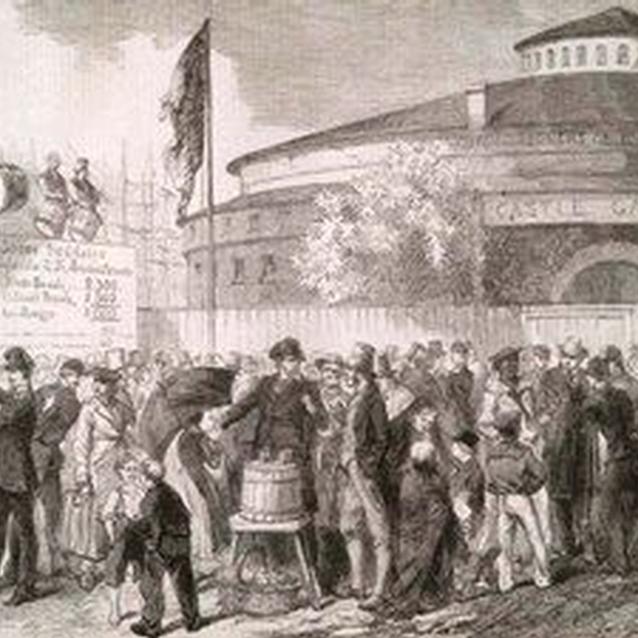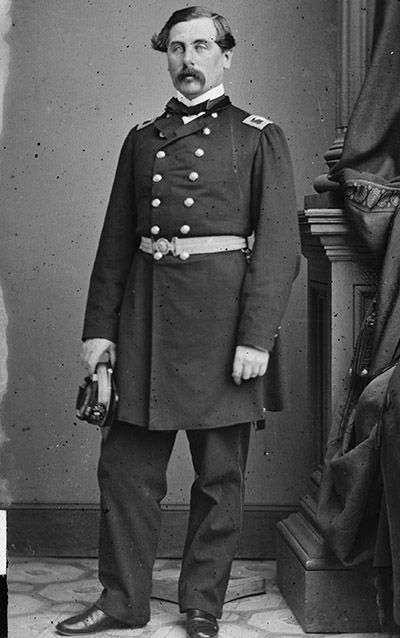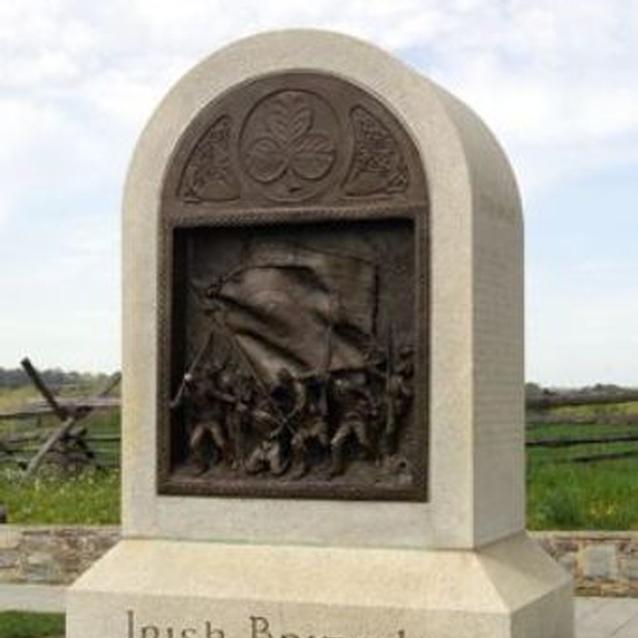While many of the men flocking to the colors to save the Union in 1861 were the grandsons of men who fought to create the nation, others were relatively new arrivals. Thousands of soldiers came from Ireland and the German states, lands which themselves were divided and torn by conflict.
"Be it for the defence, or be it for the assertion of a nation's liberty, I look upon the sword as a sacred weapon [...]by its redeeming magic the fettered colony became a daring, free Republic." Thomas Francis Meagher, 1847

The Civil War in America from the Illustrated London News
From 1846 through the mid-1850's, the potato crop in Ireland suffered a blight known as Phyophthora infestans. This water fungus was transported to Ireland from the Eastern United States, where a potato crop had been infected in the previous year. By the harvest of 1846, three quarters of the Irish potato crop had failed, leading to widespread starvation among the rural Irish. Ireland at this time was a huge agricultural power, growing wheat and raising great quantities of beef cattle and other livestock. Despite the wide-spread famine striking over three million rural Irish, the British government did not cease calling on Ireland to export food to England. Throughout the whole famine period, Ireland was a net food exporter despite the starvation of its people.
When faced with this hopeless starvation and evictions when, without crops to sell, the rural Irish farmers were unable to pay their rents, many emigrated to countries around the world. Of the approximately three million Irish suffering starvation, it is estimated that one million or more left their country, many of them bound for the United States. Of those that remained in Ireland, one million starved to death or died of disease brought on by their malnutrition.
Many of these Irish immigrants came to the major port of New York City, as well as Boston and Philadelphia. These new Irish immigrants entered the country and found that the New World had as many challenges at the Old. Coming from rural backgrounds, many Irish found themselves without the necessary skills for the new industrialized, urbanized economy that was springing up in the United States. Many Irish had to seek jobs as laborers to make ends meet, paving the streets and digging the canals of an expanding New York City while the women were forced into jobs as maids and laundresses.
Unfortunately, the Irish faced another major challenge in the United States - racism. Much of the same prejudices against the Irish, for their race and their religion, followed them to the New World. American politicians, fearful of the Irish, sought to marginalize them and created a political party, the Know-Nothing Party, whose major focus was anti-immigration xenophobia. This party believed that the Irish could not be trusted because of their "allegiance" to the Pope in Rome and because of their insular "clannish" tendencies to look after each other. While thousands of Irish were looking for work, many places would put up signs looking for help that read "Help Wanted. No Irish Need Apply." This, coupled with the religious persecution on the part of their Protestant neighbors, made the Irish community more insular. As a new political powerhouse of Irish voters began to coalesce around the machinery of Tammany Hall, many Irishmen looked for another path to acceptance in their new country - military service.

Library of Congress
Men from Ireland looking for work often joined the U.S. Army, for income and in order to find acceptance amongst Americans. Recruiters waited outside Castle Clinton, an immigrant processing center, and offered bounties to immigrants for their service. Many potential soldiers hoped to send money back to their families in Ireland, and so signed the recruitment papers and entered military service.
Many Irishmen in New York City also joined the militia, a state-run military organization that trained part-time and whose troops could be mustered into federal service in times of war.
One of the leaders of the Irish in the New York militia was Colonel Michael Corcoran, a native of Ireland and active member of the growing Irish community in New York during the 1850s. Born in Carrowkeel, County Sligo, Corcoran was forced to emigrate to the United States in 1849. He found work as a clerk but felt that he could do more, hoping that what he did and learned in the United States could be used to help free Ireland from British rule. This movement, led by the Irish Republican Brotherhood, was known as Fenianism, from the Irish word fianna meaning "band of warriors." Corcoran quickly became active in Fenian circles and looked to get Irishmen armed and trained.
To that end, he enlisted as a private in the 69th New York Militia. By 1859 he was appointed colonel of the regiment. On October 11, 1860, Colonel Corcoran refused to march the regiment on parade for the 19-year old Prince of Wales, who was visiting New York City at the time, as a protest to the ineffective British response to the Irish Famine. Corcoran was removed from command and a court martial was pending over the matter when the Civil War began. With the outbreak of war, the charges were dropped and Corcoran was restored to his command because he had been instrumental in bringing other Irish immigrants to the Union cause. In July he led the regiment into action at the First Battle of Bull Run and was taken prisoner. He was later released and died in 1863 while in command of his own Irish troops, the Corcoran Legion.
Immediately after the Union defeat at the First Battle of Bull Run in 1861, President Lincoln received a request from a captain of the New York militia, Capt. Thomas Francis Meagher, to form an ethnic Irish Brigade. Meagher was a name already well associated with the Irish, having been involved in an 1848 revolution in Ireland called the Young Ireland Rebellion. It was his rhetoric that gained him the most notoriety and nickname, Meagher of the Sword. When giving a speech about the need for revolution and reform in Ireland, he appealed to the need for physical force nationalism, counting examples of its successful use around the world.

National Park Service, Antietam National Battlefield
Convicted ex post facto by the British government for treason in the aftermath of the 1848 revolution, Meagher was sentenced to death but was given a commuted sentence - transportation to the penal colony in Van Diemen's Land, present Tasmania. Within three years, he had escaped to New York and became a prominent attorney.
Like Corcoran, he hoped to gain some military training and joined the New York Militia, commanding Company K of the 69th New York. He wrote President Lincoln and was given permission to recruit Irish regiments for the Union army. Meagher hoped to counter the resentment many Americans felt against the Irish through military service and to support the Union which had given the Irish a refuge during the famine. More joined with Meagher in hopes that the military experience they would gain in the Union army would serve them in later years to help liberate Ireland with the Fenians.
The troops of the Irish Brigade were recruited from the major centers of immigration in the Northeast and many from the ranks of the working classes, the dock laborers and canal diggers. The troops were issued weapons that were outdated by the time the war began, smoothbore 1842 Springfield muskets whose hundred yard range was dwarfed by that of the new rifled muskets. This did not deter the Irish, who would march into battle under their green silk flags, emblazoned with the harp of Ireland, and fire volleys at close range against their Confederate opponents. While their musket, firing a .69 caliber ball and buckshot, was deadly, the Irish Brigade would suffer heavy casualties.
Meagher's Irish Brigade was composed of the 63rd, 69th, and 88th New York Infantry regiments, as well as the 116th Pennsylvania Infantry and 28th Massachusetts Infantry. These Irishmen fought in the Army of the Potomac throughout the entire war. During the Battle of Antietam, they were sent against an entrenched Confederate position at the Bloody Lane, losing 60% of their strength.
Months later, the remnants of Meagher's brigade were ordered against the Confederate position at Marye's Heights at the Battle of Fredericksburg. There, in during an assault marked by ferocious Confederate resistance, they earned the praise of their enemies and comrades alike. Confederate Lt. Gen. James Longstreet thought the charge of the Irishmen "was the handsomest thing in the whole war." General Robert E. Lee declared, "Never were men so brave." Brig. Gen. George Pickett, who would make his own legendary charge within a year, thought "the brilliant assault....was beyond description....we forgot they were fighting us, and cheer after cheer at their fearlessness went up all along our line." Their division commander, Maj. Gen. Winfield Scott Hancock remarked, "General Meagher, I have never seen anything so splendid."
It cannot be forgotten, however, that the Irish did not serve in ethnic regiments alone. Throughout the Union army, Irishmen and their sons served with distinction. General Philip Sheridan was born of Irish parents and Generals James Shields and Robert Nugent were both Irish-born. With over 150,000 native Irish in uniform and countless thousands of Irish descent, the Irish fought their way to recognition in the United States through their service in the Civil War. While some anti-Irish sentiment continued through to the twentieth century, the service of men like those in the Irish Brigade brought the waves of Irish immigrants firmly into the fabric of the United States.
Last updated: August 14, 2017
